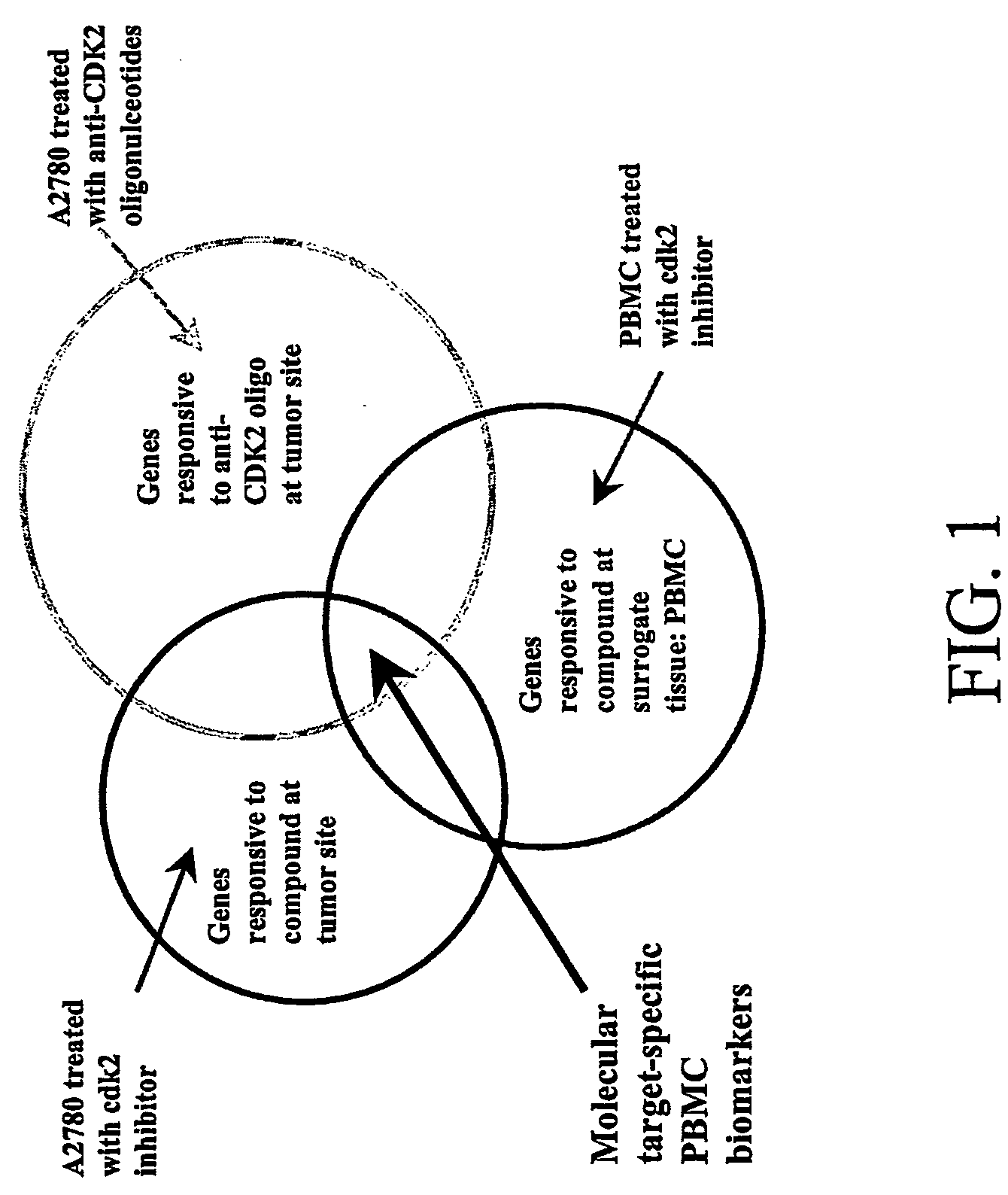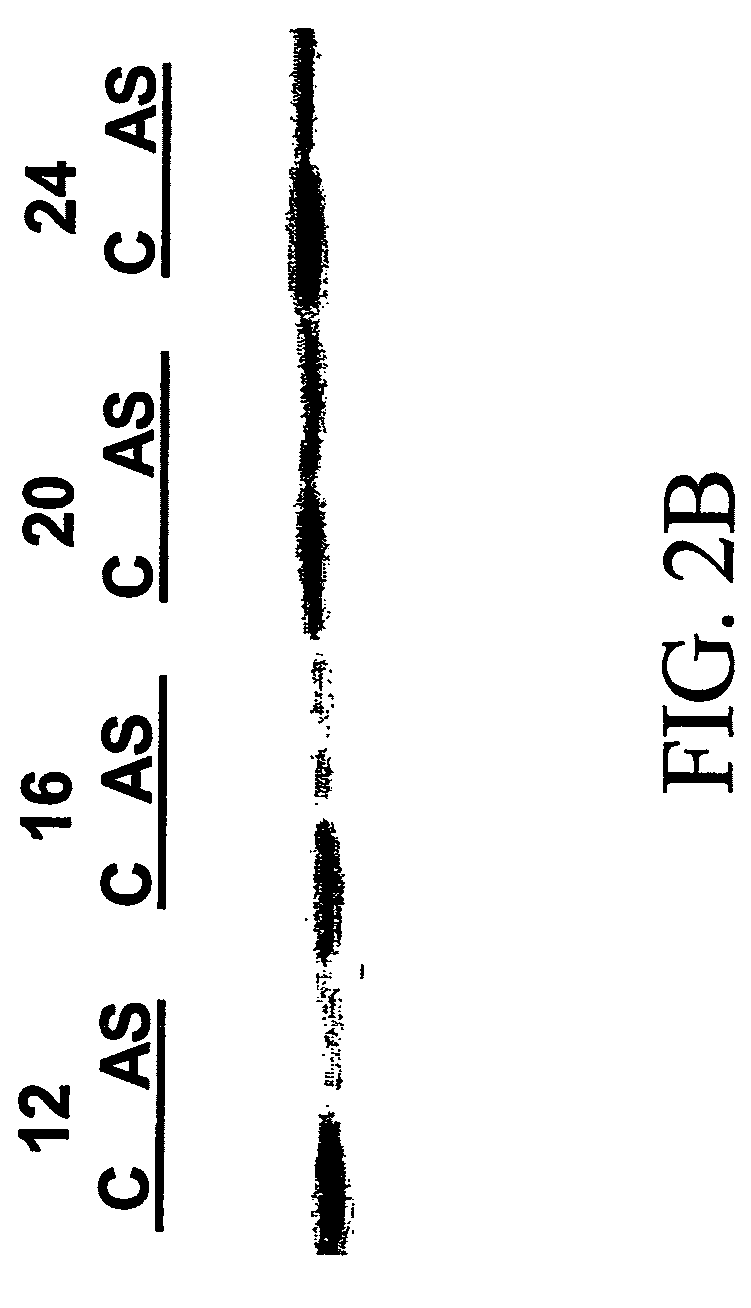Biomarkers of cyclin-dependent kinase modulation
a cyclin-dependent kinase and biomarker technology, applied in the field of pharmacogenomics, can solve the problems of loss of checkpoint control and/or inappropriate activation of the drivers of cell cycle progression, and achieve the effect of modulating cdk activity
- Summary
- Abstract
- Description
- Claims
- Application Information
AI Technical Summary
Benefits of technology
Problems solved by technology
Method used
Image
Examples
example 1
Transcription Profiling of Peripheral Blood Mononuclear Cells (PBMCs) Following Treatment with Cdk2 inhibitor, and A2780S Ovarian Carcinoma Cells Following Treatment with Cdk2 inhibitor or Anti-cdk2 Antisense Oligonucleotides
[0099] To identify biomarkers, transcriptional profiling was obtained for (i) PBMCs following treatment with cdk2 inhibitor, (ii) A2780S ovarian carcinoma cells following treatment with cdk2 inhibitor, and (iii) A2780S ovarian carcinoma cells following treatment with anti-cdk2 antisense oligonucleotides.
[0100] Table 2 lists the doses and time course used for treatment of the A2780 and PBMC cell types.
TABLE 2Experimental designDrug DoseTime courseCell TypeTreatment(nM)(hours)A2780cdk2 inhibitor0, 20, 100, 2000, 1, 2, 4, 6, 24PBMCcdk2 inhibitor0, 1000, 4, 24(pooled 10subjects)PBMCcdk2 inhibitor0, 100, 10000, 4, 24(pilot)A2780Anti-cdk2Antisense oligo and0, 12, 16, 20, 24oligonucleotidecontrol
[0101] Treatment of A2780 and PBMC was carried out as described above....
example 2
Selection of Biomarkers
[0104] In order to identify biomarkers for the cdk2 inhibitor that can be used as surrogate endpoints in PBMC and have molecular target-specific response, the expression profiles of the three sets of experiments in Example 1 were compared. Overlapping gene expression changes were selected as shown in FIG. 1.
[0105] To allow for the identification of cdk2 specific responses as well as compound specific changes at gene expression level, a statistical method was used to select genes that have gene expression changes associated with dose and time of treatment in the cdk2 inhibitor treated A2780s sample set. The data were analyzed using an analysis of variance (ANOVA) model to study the compound's dose effect and time effect on each gene. First, the data were rescaled to eliminate the chip effects by a linear regression technique. Then, an ANOVA model was fitted for each gene based on two factors—dose and time. The F-test was used to determine if there was signifi...
example 3
W28729 Upregulation
[0112] The following experimental methods were used to further study W28729 upregulation.
[0113] Patient inclusion criteria: The patient inclusion criteria included: primary solid malignancy refractory to current therapy and adequate bone marrow, hepatic, and renal function.
[0114] Treatments: Two different treatments were undertaken: (i) 174-001 Study: 1 hr infusion of BMS-387032 q 3 wks; and (ii) 174-002 Study: 24 hr infusion of BMS-387032 q 3 wks. The sampling times were pre-dose, and 2, 6, 24 hour post-dose.
[0115] W28729 Expression Analysis: RT-PCR. Patient blood samples were collected in PAXgene™ Blood Collection Tubes (Qiagen, catalog #762155). Total RNA was isolated following the manufacturer's instructions using a PAXgene™ blood RNA Kit (Qiagen, catalog #762134). W28729 and GAPDH (housekeeping gene) RNA abundance was measured by Taqman assays, using an ABI PRISM 7900 HT Sequence Detection System. W28729 abundance was normalized relative to GAPDH. Primer ...
PUM
 Login to View More
Login to View More Abstract
Description
Claims
Application Information
 Login to View More
Login to View More - R&D
- Intellectual Property
- Life Sciences
- Materials
- Tech Scout
- Unparalleled Data Quality
- Higher Quality Content
- 60% Fewer Hallucinations
Browse by: Latest US Patents, China's latest patents, Technical Efficacy Thesaurus, Application Domain, Technology Topic, Popular Technical Reports.
© 2025 PatSnap. All rights reserved.Legal|Privacy policy|Modern Slavery Act Transparency Statement|Sitemap|About US| Contact US: help@patsnap.com



